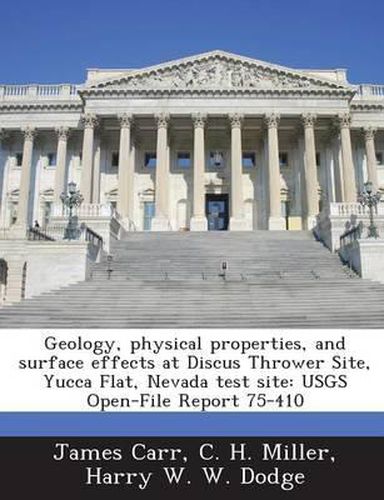Readings Newsletter
Become a Readings Member to make your shopping experience even easier.
Sign in or sign up for free!
You’re not far away from qualifying for FREE standard shipping within Australia
You’ve qualified for FREE standard shipping within Australia
The cart is loading…






Geologic studies in connection with Project Discus Thrower have furnished detailed stratigraphic and structural information about northwestern Yucca Flat. The Paleozoic rocks consist of a lower carbonate sequence, argillite of the Eleana Formation, and an upper carbonate sequence. The distribution of these rocks suggests that both top and bottom of the Eleana are structural contacts, probably thrusts or reverse faults. The overlying tuff includes several units recognized in the subsurface, such as the Fraction Tuff and tuff of Redrock Valley. Other units recognized include bedded tuff associated with the Grouse Canyon Member of Belted Range Tuff, and the Rainier Mesa and Ammonia Tanks Members of the Timber Mountain Tuff. The Timber Mountain and Grouse Canyon are extensively altered to montmorillonite (a swelling clay), possibly as a result of ponding of alkaline water. The overlying alluvium locally contains at the base a clayey, tuffaceous sandstone. Geophysical logs were used as an aid in locating geologic contacts and determining in situ physical properties. Graphic logs are presented that show the correlation of lithology and geophysical logs. Many of the rock units have characteristic log responses, but alteration within rock units affects the logs strikingly in some drill holes. The most significant surface effect of the experiment was the formation of a 4-foot fault scarp northwest of the site.
$9.00 standard shipping within Australia
FREE standard shipping within Australia for orders over $100.00
Express & International shipping calculated at checkout
Geologic studies in connection with Project Discus Thrower have furnished detailed stratigraphic and structural information about northwestern Yucca Flat. The Paleozoic rocks consist of a lower carbonate sequence, argillite of the Eleana Formation, and an upper carbonate sequence. The distribution of these rocks suggests that both top and bottom of the Eleana are structural contacts, probably thrusts or reverse faults. The overlying tuff includes several units recognized in the subsurface, such as the Fraction Tuff and tuff of Redrock Valley. Other units recognized include bedded tuff associated with the Grouse Canyon Member of Belted Range Tuff, and the Rainier Mesa and Ammonia Tanks Members of the Timber Mountain Tuff. The Timber Mountain and Grouse Canyon are extensively altered to montmorillonite (a swelling clay), possibly as a result of ponding of alkaline water. The overlying alluvium locally contains at the base a clayey, tuffaceous sandstone. Geophysical logs were used as an aid in locating geologic contacts and determining in situ physical properties. Graphic logs are presented that show the correlation of lithology and geophysical logs. Many of the rock units have characteristic log responses, but alteration within rock units affects the logs strikingly in some drill holes. The most significant surface effect of the experiment was the formation of a 4-foot fault scarp northwest of the site.